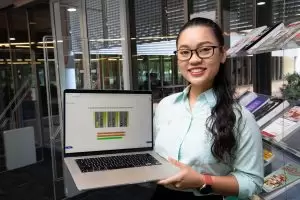From floating chopsticks in space to natural disaster damage mapping, here’s what three innovative engineering students are working on this year.
Software engineer: Jade Doan
Jade Doan, a Master of Software Engineering student at Charles Darwin University, is tackling a mammoth feat: developing an app from the ground up to make it easier for Territorians to get their driver’s licence.
The app, called NT Driver’s License Helper, is designed to make studying for a driving test more accessible, particularly newcomers to Australia – including Doan herself – and to offer a more interactive learning experience.

“The resources felt overwhelming. You’re confronted with a 200-page PDF file,” Doan told create.
“The idea came from my own experiences when applying for my Australian driver’s licence. Because I come from another country, everything was entirely different and very challenging.
“My friends experienced the same difficulties, which motivated me to create the app.
But, as Doan explained, developing an app from scratch is no easy task.
“It has been a challenging process. I’m coding the app myself – something I have had to learn – and the project is a solo one, so it relies on me learning these things.
“I’ve been lucky enough to receive valuable advice from my professors and peers, which I have used to improve the functionality and user experience.”
As a young girl, Doan was told that “IT isn’t for girls”, something she initially listened to.
“I was too young to oppose the statement and during that time, Vietnam wasn’t a society that welcomed or supported women eager to explore technical careers. I obeyed my parents and began my education in teaching mathematics.
“After a few years of sticking to that, I felt it wasn’t suited to me. I didn’t find it interesting and wanted to try something new.”
Now in the throes of her software engineering studies, Doan feels inspired to put her technological skills to use in this impactful project.
“The app is 60 per cent of the way there,” she said. “The plan is to make the app as accessible as possible. If you have an internet connection, it will work.”
Aerospace engineer: Shingo Nishimoto
Microgravity and chopsticks? Australian National University aerospace engineering student Shingo Nishimoto is putting the two together in a unique experiment.
As part of the Asian Try Zero-G competition, Nishimoto was selected to put his theory into practice at the International Space Station in Japan.
“The experiment aimed to assess the change in the motion of rotating objects in a microgravity environment,” he explained.
“In this experiment, the astronauts have two chopsticks which are bundled together by a rubber band. Once they are released, we analyse the change in formation and rotation.
“One of the most important things to observe is the long duration of the phenomena. Because of microgravity, the chopsticks can hold their position for a long time.”
“When we try this from the ground, however, we aren’t able to observe it with the same level of detail. The zero-gravity environment offers a longer iteration of what we’re trying to see.”
Nishimoto’s trip to his home country, Japan, was a successful one, allowing him not only to prove his hypothesis, but also engage with other students from across the globe.
“I started studying aerospace engineering in my undergraduate degree”, he told create, “it is something I would like to pursue long-term as I continue to be driven by curiosity.”
Geospatial engineer: Chang Liu
From serious earthquakes to blazing bushfires, Chang Liu, PhD student at the University of New South Wales, is mapping out the immediate aftermath of natural disasters, helping those on the ground to better approach the rebuilding process.
“My research looks at post-disaster building damage classification,” she explained. “In the first year of my PhD, I noticed that there are usually only two categories that classify the extent of damage to buildings. We need more detailed information, which is why this research came about.
“I have decided to classify the damage based on four levels: total damage, major damage, minor damage and unknown damage.”
In the early stages of research, Liu focused specifically on earthquakes. Now, she explained, there are more types of natural disasters that could benefit from her technology.
“I’m using both satellite images and LiDAR data to assess building damage. Combined, these technologies are able to provide detailed information – from the location’s temperature to the extent of damage.”
Liu referenced the recent earthquake in Taiwan as an example of an incident that could greatly benefit from this technology.
“When a natural disaster occurs, these deep learning models can be used to assess the damage levels in a very short period of time, helping to develop better recovery strategies.”